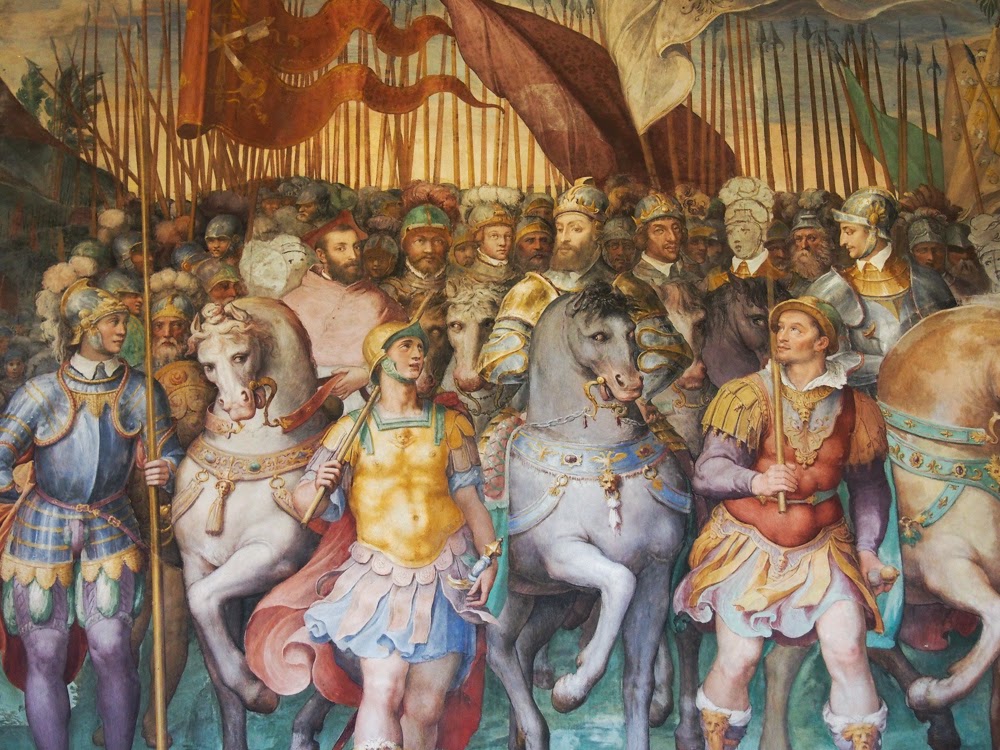 What?
What? A stunning Renaissance palace, covered with art from floor to ceiling.
Why visit?
This massive building gives most of the famous palazzi in Rome a run for their money.
Filled with some of the best examples of Renaissance and Mannerist art in Italy, you will have this palace practically all to yourself.
If you like painting and Renaissance art, the Farnese family's humble abode will not disappoint.
Where?
The little town of Caprarola, day-trip distance (about 70km) from Rome, and 20km from Viterbo. Map.
THE FARNESE FAMILY played a crucial role in a well-known Italian organization of mixed repute, with its power base firmly set in the southern half of Italy and a growing international footprint. The Farnese clan was one of the more powerful families within this organization, with its own territory clearly staked out, offering protection (or else...) in return for cash.
But when Alessandro Farnese was made Capo di tutti Capi, the family's fortunes rose even further, as he became one of the most powerful men in Europe. He aggressively promoted the interests of La Famiglia and dealt ruthlessly and violently with those who opposed him and his organization.
I am talking of course about the Roman Catholic church and Farnese's election to the Papacy in 1534.
During his reign, as Paul III, he stuffed the family coffers and reinvigorated the Inquisition to deal with the Reformation. He also put the word 'nepote' in 'nepotism', by, barely 2 months into his papacy, awarding two of his 'nephews' (nepote in Italian, but since cardinals and popes were not supposed to be married, these 'nephews' were often (illegal) offspring) with cardinalships at the wise ages of 14 and 16.
 |
| The Farneses weren't shy about nepotism. This fresco from one of the palace walls shows Pope Paul III Farnese bestowing a title upon one of his nepoti. |
'Godfather' Pope Paul III and his grandson, Cardinal Alessandro Farnese, were responsible for turning this site into the palace we see today.
 |
| View of the Palace today... |
 |
| ...and as seen a few 100 years ago, painted inside the palace's entry hall. |
 |
| A staircase fit for a king, pardon, pope. |
 |
| Roman-inspired 'grotesque' frescoes in the staircase. |
 |
| Warning: if you like your interior decoration minimalist, this place is not for you! |
 |
| My personal favourite: Mercury and Minerva. |
 |
| Alessandro Farnese chilling with his mates, the Holy Roman Emperor Charles V and Henry II of France, ready to squash the Protestants. |
 |
| The Palazzo dominates the tiny town of Caprarola. |
However, the largest part of the garden is not visible and must be visited separately. At the time of writing, visits were only possible on weekdays between 10-11h and 12- 15h. Current opening hours can be found here.
Getting there:
Caprarola is about an hour's drive north of Rome, following the ancient Via Cassia. Or there are 6 COTRAL buses a day from Viterbo.
There are several other great gardens in the area- for more on them, check out our post about 4 Renaissance gardens near Rome on Lazio Explorer.
Useful links:
Official website.




love this area
ReplyDelete